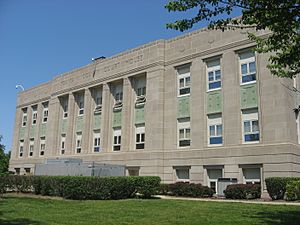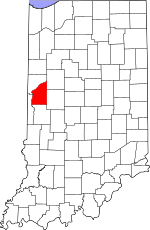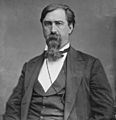Fountain County, Indiana facts for kids
Quick facts for kids
Fountain County
|
|
|---|---|

Fountain County Courthouse
|
|

Location within the U.S. state of Indiana
|
|
 Indiana's location within the U.S. |
|
| Country | |
| State | |
| Founded | April 1, 1826 |
| Named for | James Fontaine |
| Seat | Covington |
| Largest city | Attica |
| Area | |
| • Total | 397.88 sq mi (1,030.5 km2) |
| • Land | 395.66 sq mi (1,024.8 km2) |
| • Water | 2.22 sq mi (5.7 km2) 0.56%% |
| Population
(2020)
|
|
| • Total | 16,479 |
| • Density | 41.4170/sq mi (15.9912/km2) |
| Time zone | UTC−5 (Eastern) |
| • Summer (DST) | UTC−4 (EDT) |
| Congressional district | 4th |
| Indiana county number 23 FIPS code 045 |
|
Fountain County is located in the western part of Indiana, a state in the United States. It sits on the east side of the Wabash River. The county was officially started on April 1, 1826. It was the 53rd county created in Indiana. The main town, or county seat, is Covington.
In 2020, about 16,479 people lived here. Fountain County has two cities and six towns. It also has many smaller communities. The county is divided into eleven areas called townships. These townships help provide local services. Important roads like an interstate highway and U.S. Routes cross the county. A major railroad line also runs through it.
Contents
History of Fountain County
Indiana became a state in late 1816. The first non-Native American settler in what would become Fountain County arrived in 1823. More settlers soon followed. The law that created Fountain County was passed on December 30, 1825. It officially started on April 1, 1826. The county's borders have stayed the same ever since.
The county was named after Major James Fontaine. He was from Kentucky and was killed in a battle in 1790. This battle was part of the Northwest Indian War.
Courthouses in Covington
The first courthouse in Fountain County was built in Covington in 1827. It was a two-story wooden building. In 1829, plans were made for a bigger courthouse. After some changes, a brick courthouse was finished in 1833.
A third courthouse was built between 1856 and 1857. It cost $33,500. Sadly, it was mostly destroyed by fire in January 1860. The same day, the circuit court met there for the first time! Isaac Hodgson designed the rebuilt courthouse. It was ready in January 1861. The total cost, including rebuilding, was over $54,000.
The courthouse you see today was built in 1936–1937. It cost about $246,734. It replaced the old building, which was no longer safe. The Jacobson Brothers from Chicago built it. The architects were Louis R. Johnson and Walter Scholar. Inside, the walls have large murals painted by Eugene Francis Savage and others. These paintings show how western Indiana was settled.
Canals and Railroads
Work on the Wabash and Erie Canal began in 1832. It reached Lafayette by 1842. By 1846, the canal reached Covington. Boats started using it to travel through the county in 1847.
However, the first railroad line was built in the 1850s. This made the canal less useful. In 1875, the last canal boat passed through Covington.
The first railway line was the Toledo, Wabash and Western Railway. It reached Attica in 1856. Another railroad, the Indianapolis, Crawfordsville and Danville Railroad, started in 1855. It was finished in 1870 and began service in 1871. This line passed through Covington, Veedersburg, and Hillsboro.
Geography of Fountain County
Fountain County's northern and western edges are formed by the Wabash River. This river flows southwest from Tippecanoe County.
The county covers about 397.88 square miles. Most of this area (about 99.44%) is land. The rest is water. The land in the county slopes towards the southwest. This means water drains into the Wabash River. About 84% of the county's land is used for farming.
The Portland Arch Nature Preserve is a special natural area. It is located near the Wabash River.
Neighboring Counties
- Warren County - north
- Tippecanoe County - northeast
- Montgomery County - east
- Parke County - south
- Vermillion County - southwest
Towns and Cities
Cities
Towns
Small Communities
Old Settlements
- Stringtown - an old mining town that is now abandoned.
Townships
- Cain
- Davis
- Fulton
- Jackson
- Logan
- Millcreek
- Richland
- Shawnee
- Troy
- Van Buren
- Wabash
Transportation
Highways
Interstate 74 goes east and west through the middle of Fountain County. US Route 136 also runs east and west. It generally follows I-74. US Route 41 runs north and south. It passes through Attica and Veedersburg.
Three state roads cross the county from east to west:
- State Road 28 enters Attica and crosses the northern part of the county.
- State Road 32 enters from the west and goes through the middle of the county.
- State Road 234 is further south. It enters from the west and passes through Kingman.
Two state roads run north and south:
- State Road 55 goes through Attica. It then shares a route with US Route 41 going south. At Rob Roy, it turns southeast.
- State Road 341 starts at State Road 28 in the north. It runs south and ends at State Road 234.
Railroads
A Norfolk Southern Railway line crosses the northern part of Fountain County. It connects Danville, Illinois and Lafayette, Indiana. About 45 freight trains use this line every day.
Air Travel
There are no public airports inside Fountain County. People can use nearby airports for air travel:
- Purdue University Airport in Tippecanoe County. It is Indiana's second busiest airport.
- Indianapolis International Airport is about 70 miles east of Fountain County.
Climate and Weather
| Weather chart for Covington, Indiana | |||||||||||||||||||||||||||||||||||||||||||||||
|---|---|---|---|---|---|---|---|---|---|---|---|---|---|---|---|---|---|---|---|---|---|---|---|---|---|---|---|---|---|---|---|---|---|---|---|---|---|---|---|---|---|---|---|---|---|---|---|
| J | F | M | A | M | J | J | A | S | O | N | D | ||||||||||||||||||||||||||||||||||||
|
1.9
32
15
|
1.8
38
20
|
2.8
49
29
|
3.4
62
39
|
4.3
73
50
|
4.5
82
60
|
4.2
85
63
|
3.7
83
60
|
3.1
77
52
|
2.8
65
41
|
3.2
50
33
|
2.5
37
21
|
||||||||||||||||||||||||||||||||||||
| temperatures in °F precipitation totals in inches source: The Weather Channel |
|||||||||||||||||||||||||||||||||||||||||||||||
|
Metric conversion
|
|||||||||||||||||||||||||||||||||||||||||||||||
Fountain County has a humid continental climate. This means it has cold winters and hot summers. In Covington, the average temperatures range from 15°F in January to 85°F in July. The lowest temperature ever recorded was -26°F in January 1994. The highest was 105°F in August 1988.
The amount of rain and snow changes throughout the year. February usually has the least, with about 1.80 inches. June usually has the most, with about 4.53 inches.
Between 1950 and 2009, six tornadoes were reported in Fountain County. Luckily, none of them caused any deaths.
Education
Three public school systems serve Fountain County:
- Attica Consolidated School Corporation: This system serves the northern part of the county. It includes Attica Elementary and Attica Junior–Senior High Schools.
- Covington Community School Corporation: This system serves western Fountain County. It includes Covington Elementary, Covington Middle, and Covington High Schools.
- Southeast Fountain School Corporation: This system serves eastern Fountain County. It includes Southeast Fountain Elementary and Fountain Central Junior–Senior High Schools.
Notable People
Daniel Wolsey Voorhees
Daniel Wolsey Voorhees was born in Ohio but grew up in Fountain County. He went to school in Veedersburg. After college, he became a lawyer in Covington. He later moved to Terre Haute. He served as a United States Senator from 1877 to 1897. He was known for his speaking skills. He passed away in Washington in 1897.
John T. Myers
John Myers was born in Covington in 1927. He graduated from Covington High School. He served in the United States Army. Later, he served in the United States House of Representatives from 1967 to 1997.
Population Information
| Historical population | |||
|---|---|---|---|
| Census | Pop. | %± | |
| 1830 | 7,619 | — | |
| 1840 | 11,218 | 47.2% | |
| 1850 | 13,253 | 18.1% | |
| 1860 | 15,566 | 17.5% | |
| 1870 | 16,389 | 5.3% | |
| 1880 | 20,228 | 23.4% | |
| 1890 | 19,558 | −3.3% | |
| 1900 | 21,446 | 9.7% | |
| 1910 | 20,439 | −4.7% | |
| 1920 | 18,823 | −7.9% | |
| 1930 | 17,971 | −4.5% | |
| 1940 | 18,299 | 1.8% | |
| 1950 | 17,836 | −2.5% | |
| 1960 | 18,706 | 4.9% | |
| 1970 | 18,257 | −2.4% | |
| 1980 | 19,033 | 4.3% | |
| 1990 | 17,808 | −6.4% | |
| 2000 | 17,954 | 0.8% | |
| 2010 | 17,240 | −4.0% | |
| 2020 | 16,479 | −4.4% | |
| 2023 (est.) | 16,731 | −3.0% | |
| US Decennial Census 1790-1960 1900-1990 1990-2000 2010 |
|||
According to the 2020 United States Census, Fountain County had 16,479 residents. Most people living in the county were White (93.6%). About 2.5% of the population was of Hispanic or Latino background.
Images for kids
See also
 In Spanish: Condado de Fountain para niños
In Spanish: Condado de Fountain para niños




